The programme for this year’s research seminar series can now be downloaded here: Cesma. We welcome anyone who is interested in the interests and concerns of the Centre for the Study of the Middle Ages.
Author: cesmablog
‘More Facts and Less Mudslinging’: PG Workshop in Pre-Modern Public Health
Postgraduate Workshop in Pre-Modern Public Health, hosted by Professor Guy Geltner
Danford Room, Arts Building room 224, Tuesday 17th October, 9am-11am
Following on from the CeSMA seminar on Monday 16th October, Guy Geltner of Universiteit van Amsterdam is hosting a workshop which aims to address, and potentially revise, medieval cities’ poor reputation for cleanliness and hygienic proactivity. Through an examination of primary source material we will think about the implications and possible connections that come from reading such documents, as well as the methodologies and theoretical approaches that underlie them.
In order to get the most out of the workshop, attendees are asked to complete the pre-reading of both the primary source material and the two secondary texts. More details of the workshop and the pre-reading are contained in the files below:
Premodern Public Health Workshop Birmingham Overview
Chew and Kellaway London Assize of Nuisance
Kowaleski Reader on Urban Hygiene
Dean Reader on Netezza Urbana
Rawcliffe 2013 Urban Bodies
Geltner 2013 Healthscaping a Medieval City
Undergraduate and Postgraduate Research Placement: Italian Women’s Writings in the Medieval Period
Adnan Khan discusses his research on women’s book usage in fifteenth and sixteenth century medieval Italy.
With this project aiming to analyse female book ownership in Europe and beyond, Italy is one of the most important regions to be considered by historians given its central role in the Renaissance. This blog will highlight the research undertaken in this interdisciplinary research project in understanding what work on this topic has been done in the secondary literature, and the areas of analysis in this field that still require investigation. The picture below shows Florence, the birthplace of the Renaissance.
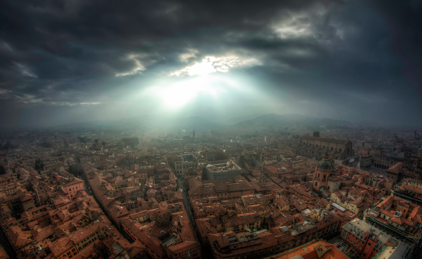
In the study of women’s book usage in Italy in the medieval period, historians have focussed considerably on the ‘long sixteenth century’. The period from 1580-1630, saw 66 single authored works written by Italian women. These varied in form including epic poems, pastoral dramas, tragedies, romances, and secular and religious works. This period therefore saw women become established in literary genres which had been previously dominated by male writers. However, this process of larger female book writing and usage can be understood further back than the sixteenth century alone, with important developments starting in the fifteenth century.
As has been studied by Virginia Cox, female book writing was a process that started far earlier in the Renaissance than has previously been stressed by scholars. Prior to the Renaissance, women had undertaken some religious writings however within the secular genre that emerged in the fifteenth century a new secular, cultural profile was created which Cox’s terms ‘the learnt woman’. This new profile that developed meant that it became socially more acceptable for women to write books alongside men, with this flourishing in the following century.
Two pioneers of the female women’s sixteenth century writings were Veronica Gambara (1485–1550) and Vittoria Colonna (1490–1547). Gambara was born in Pralboino and received a humanist education studying philosophy, scripture, theology, Greek and Latin. Gambara wrote many poems, with 80 of these available in English translation today. Colonna was also a highly influential poet from Pescara writing five major collections of poetry such as the Rime de la Divina Vittoria Colonna Marchesa di Pescara. However, from Cox’s research, she has found that both these women are genealogically connected to notable dynasties of “learned women” like the Nogarola of Verona and the Montefeltro of Urbino living in the fifteenth century. Therefore, the cultural profile of ‘the learnt woman’ created by the female elite in the fifteenth century saw the emergence of the vast literary works of similarly elite women in the following century. Yet, the image of the learnt Renaissance women was always restricted to the elite woman who had the opportunity to write and use books from the humanist education they received. How far this stretched to the poorer and less influential members of Italian Renaissance society however needs to be addressed by scholars despite the limited evidence available.

Undergraduate and Postgraduate Research Placement: The Writings of Anna Comnena in 12th Century Constantinople
Adnan Khan shares his research on Anna Comnena and her writings on the Byzantine Empire.

This blog investigates European, medieval women’s writings on the edge of the continent in what is now present day Istanbul, Turkey. With much of the historiography on women’s writings in Europe focussing on an Anglo-Burgundian axis in Western Europe, this blog seeks to highlight the research that can be done outside of this. This blog will focus on the case study of Anna Comnena, and how her works represent the opportunities for Byzantine women to interact with book usage and writing.
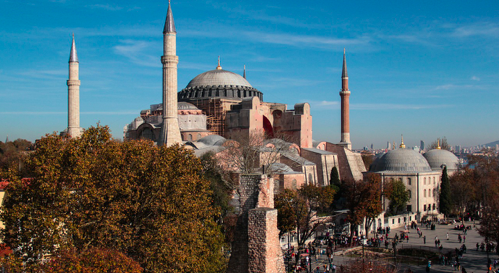
Anna Comnena, 1083-1153, was born in Constantinople, the capital of the Byzantine Empire. Anna was born in purple being the daughter of Emperor Alexios I and, given this privileged upbringing, was taught through a monastery studying history and philosophy and the work of scholars like Aristotle. Anna wrote histories on her father’s rule, documenting political events some of which she saw first-hand. These histories have been collated and translated into English in The Mexiad of the Princess Anna Comnena. These works sort to venerate her father above his successors with Anna’s analysis on the First Crusade one of the few Byzantine accounts still available.
Anna’s emergence as a historian was not common within twelfth century Byzantine society, despite her elite upbringing. A princess typically did not comment on the life of an Emperor and record this down for future generations to read. Anna was known throughout Constantinople for her intellectual capability and her knowledge of political and Christian practices which is highlighted by accounts provided by Anna’s contemporaries such as the Bishop of Ephesus, Georgios Tornikes. Furthermore, when Anna’s husband the historian Nikephoros Bryennios the Younger died in 1137, Anna would go onto finish his incomplete works in Greek documenting relations between the Byzantine Empire and the West.
Therefore, Anna is an example of a Byzantine women who given her elite birth was able to act beyond the expectations of her as a princess, completing some of the most important historical writings in the period. Furthermore, Anna was able to do this based upon her intellectual ability which reflects upon Byzantine society with similar examples available from other regions of Europe like Italy and Spain. Yet, the importance of Anna’s writings in documenting the life of the Emperor is an exceptional case which with further research may find parallels in other neighboring regions in the Middle East and beyond.
‘Fifth Annual Medieval and Renaissance Symposium’, St Louis University, Missouri, 19th – 21st June 2017
The Symposium is now in its fifth year and its stated aims are: to provide a convenient summer venue in North America for scholars in all disciplines to present papers, organize sessions, participate in roundtables, and engage in interdisciplinary discussion. The promotion of serious scholarly investigation into the medieval and early modern worlds was at the heart of this Symposium.
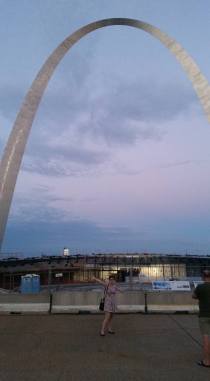
We formed a panel entitled ‘Interacting with Saints and Shrines: Text, Image and Material Cultural’. The session explored engagements with cults and shrines in a variety of contexts and media, with specific focus on the cult of St Æthelthryth of Ely; the Cistercian Order in the twelfth century; and southern Italian shrines in the high Middle Ages. The papers demonstrated how images, material culture and texts were utilised to portray saints and engage with the lay communities, thus ensuring that the religious institutions’ messages were heard and disseminated. Thanks to conference travel grants from CeSMA, the Royal Historical Society, and Midlands3Cities, we were able to participate in this international conference to present the paper and take advantage of the networking opportunities offered by this established Symposium.
The meeting included plenary sessions by Bruce Campbell, Christopher Baswell and Damian Smith. Campbell’s talk entitled ‘Unemployment, Leisure and Industriousness in Late-Medieval and Renaissance Europe built on the work of Phelps Brown and Hopkins from the 1950s which profiled daily wages from 1250 through to 1900. He advocated a more nuanced approach which incorporated detail relating to gender and geographical differences and the variation between real and nominal wages, highlighting anomalies in the traditionally held view. Baswell examined the depictions of disability in thirteenth century Arthurian romance literature, which up to now has been underexplored in scholarship and encouraged further work in the field. While Smith expanded on his current topic of research on James I of Aragon by considering the existing scholarship surrounding his legitimacy to the crown of Montpellier.
Unfortunately, several speakers were unable to attend which resulted in a number of panels containing only one or two papers. However a wide variety of subjects were explored in the papers we attended. Burnam Reynolds explored the appearance of celestial beings at the battle of Antioch and considered how and why such an account was accepted in Western Christendom; whether the Turin shroud was included in the booty from the fourth crusade was addressed by Thomas Madden; the change in crusading policy by Gregory X following the death of Louis IX was examined by Samantha Cloud; Cathleen Fleck analysed the depiction of Robert I of Naples as King Solomon in the Anjou bible, suggesting that it was an attempt to reinforce his rule on the Italian peninsula; and Anne Carmichael argued that the plague policy in 15th century Milan was not imposed from above but a result of a collaboration between the community and health officials. Throughout the Symposium the importance of best practice in presentation technique became evident as we observed the different styles used by the speakers.
The atmosphere throughout the conference was

collegiate with receptions on each evening providing the opportunity to discuss papers and research projects further. We have appreciated the chance to attend and present at this established Symposium and look forward to incorporating some of the ideas and methodology into our own research.
by Georgie Fitzgibbon
CeSMA at Kalamazoo: Cross-Cultural Studies of the Book
Birmingham CeSMA, in conjunction with the University of Illinois–Urbana-Champaign, sponsored a panel at Kalamazoo this year on ‘Cross Cultural Studies of the Book’ which meant little old me, your friendly neighbourhood web editor, took my research stateside for the first time (and braved my first transatlantic flight) to make some friends in the ‘Zoo across the pond.
Having heard some rumours about the on-campus accommodation, which many of my colleagues were resolutely enjoying with a sense of festive cameraderie, I settled myself in the Holiday Inn and hoped that jetlag wouldn’t be too bad.
The campus of WMU (Western Michigan University) was beautiful, and we were blessed with amazing weather (should have brought suncream), and the conference has an impressive infrastructure that includes regular shuttle-buses that run between the different hotels and the different buildings of campus. I didn’t get lost once, either, which is more than I can say about my various times at the Leeds IMC where, on entering the union building, I always seem to open doors to find something different behind them from what I expected.
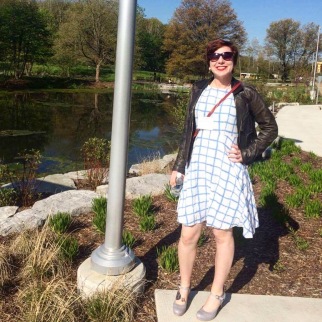
CeSMA’s panel was on the Friday, the third day of the conference, and by then I was feeling like a true American. I’d got a little more used to the timezone, and waking extra early was making me feel very virtuous and productive.
Our panel began with Carol Symes from the University of Illinois–Urbana-Champaign giving a paper on ‘Before and beyond the King’s Book: Reading the Material Remains of the Domesday Survey’. Carol’s paper was a fascinating look not just into the Domesday book and how it was compiled, but also into our own (mis, sometimes)conceptions of how it came about.
I was up next, with my paper on everyone’s favourite (and by far the best) saint, Saint Margaret of Scotland, ‘English Books at a Scottish Court: The Books of Saint Margaret of Scotland (d. 1093)’. In my paper, I argued that these books were essential artefacts for understanding the roles that foreign queens were expected – and indeed needed – to play at the courts they married into. Carol very kindly invited me to publish this in her journal, The Medieval Globe, so keep your eyes peeled for that!
Our final panellist was Sean Winslow of the University of Toronto. There had been a bit of shuffling around, and some panellists unable to attend, so Carol and I invited Sean to join our panel, which was not without controversy! Sean was speaking on ‘The Ethiopian Book between Christendom and Islam’, and this raised some interesting issues about framing a cross-cultural panel and considering the book as a global object. For Carol and me, making northern European Latin-based medieval studies globally-focussed and outlooking is an essential issue, and the panel was a great opportunity to develop an outward-looking conceptual framework for future work.
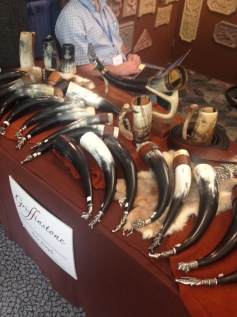
The conference was just as rich in extra-curriculars as it was in academic papers. Aside from the famous disco, there was ‘wine hour’ every day which provided an excellent opportunity for catching up with friends and colleagues from around the world, some excellent stalls to tempt us, and activities of every kind.
I had a wonderful time at Kalamazoo, and it was brilliant to connect Birmingham’s CeSMA with the medieval studies work going on at the University of Illinois–Urbana-Champaign. It’s worth the jetlag, and the fact that you have to ride the airport train past Trump Tower to get to Chicago central train station and on to Kalamazoo. I’m sure this is the beginning of a long and beautiful transatlantic partnership of scholars.
Claire Harrill
University of Birmingham
CeSMA Web Editor
International traveller??
@Claire_Harrill
NEWS! CeSMA Conversations Next Week
News from York: RECOVERING THE PAST Conference
RECOVERING THE PAST
To be held 2nd-3rd June, 2017
Kings Manor, University of York
Organised by Elizabeth Alexander (York) and Lyndsey Smith (York)
Keynote given by Professor Rosemary Sweet
Recovering the past can be an arduous and treacherous task and modern scholars frequently find themselves indebted to those who have gone before them. This multi-disciplinary two-day conference sets out to celebrate and analyse the impact the work of previous generations has had on our understanding of the Medieval past. For example, from the mid-nineteenth century onwards there appears to have been an increased interest in cataloguing and preserving the sculpture of the early Medieval period by figures such as John Romilly Allen and Joseph Anderson, whose seminal work The Early Christian Monuments of Scotland, published in 1903, is still the most complete record of the sculpture of early Medieval Scotland and was an influencing factor behind the creation of the British Academy Corpus of Anglo-Saxon Stone Sculpture (which published its twelfth volume in 2016), the key text for any scholar working on Anglo-Saxon monumental sculpture and ecclesiastical / secular patronage of the arts in the early Middle Ages. This recording and cataloguing of the past can also been seen during the Medieval period itself with the collation of earlier oral poetry being preserved in manuscripts, such as the ninth-century poem Genesis Bpreserved within the c. 1000 Bodleian Junius 11 manuscript-version of the near contemporary poem Genesis.
Wider examples of recovering the past include, but are not limited to: recovering the past given the issues surrounding the accuracy/authenticity of primary sources; excavation and/or scientific analysis, the insights these provide and the issues surrounding the findings; the recovery of lost or stolen artefacts during the Medieval period and beyond; highlighting the skewing of the past through the editing of texts since the later sixteenth century, the production of fakes, the re-carving of sculpture; highlighting the use and manipulation of the past to support nationalistic/religious arguments; the varying interests of antiquarians and early historians; as well as museology and the questions surrounding how we engage with and display the Medieval past.
This conference will bring together emerging scholars, early career researchers and established academics from a variety of disciplines to provide a platform to discuss how this important idea was manifested in the textual, visual and material evidence of the Medieval world and beyond. It aims to examine the implications and the significance of ‘recovering the past’ in its widest possible contexts.
News! CeSMA’s Arezou Azad giving a special lecture at Pembroke College, Cambridge, May 11th
Crossing Borders Conference Report
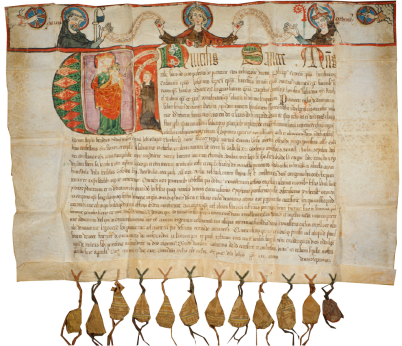 3rd-5th of April this year, we were delighted to host the second biennial ‘Crossing Borders’ conference. We had a wealth of distinguished speakers from all round the world, wonderful panels of diverse border-crossing papers and excellent opportunities for discussions across those borders.
3rd-5th of April this year, we were delighted to host the second biennial ‘Crossing Borders’ conference. We had a wealth of distinguished speakers from all round the world, wonderful panels of diverse border-crossing papers and excellent opportunities for discussions across those borders.
We began on 3rd April with three papers on scribes, patrons and interventions. Keith Busby from the University of Wisconsin spoke on ‘The Irishman and the Walloon: Jofroi de Waterford, Dominican, and Servais Copale, Tax-Collector’, our own Wendy Scase on the Book of Margery Kempe ‘‘Neithyr good Englysch ne Dewch’: Scribes across Borders’ and Kate McClune from the University of Bristol on ‘A Scottish Renaissance? King James VI, John Stewart of Baldynneis and Ariosto’s Orlando Furioso’.
For our keynote we were delighted to have Carolyne Larrington of St John’s College, Oxford speaking on ‘Vestr komk of ver (Again): Egill Skalla-Grímsson in England.’ This saga is the story of a tenth-century Icelander’s border-crossing exploits. It bears witness to the fact that there was an awareness of which countries in Europe were rich and where was good to travel, so the text bears witness to cultural border-crossing.
Our second day began with a panel on insular geographies with Helen Fulton of the University of Bristol talking on ‘Medieval Caerleon as a Monument: Spatial History in a British Border Town’, Rebecca Thomas of St John’s College, University of Cambridge on ‘Armes Prydein Vawr‘s Britain’ and Sif Ríkharðsdóttir from the University of Iceland speaking on ‘Oceanic Networks’.
The next session was devotional texts and hagiography across borders. We had Elena Parina of Philipps-Universität Marburg / Institute of Linguistics RAS, Moscow speaking on ‘The Middle Welsh ‘Sunday Letter’ and its Latin Source’, Erich Poppe from the Philipps-Universität Marburg on ‘Convergent devotional needs – divergent texts and traditions: the ‘Sunday Letter’ and the ‘Transitus Mariae’ in Wales and Ireland’, and Sonja Schnabel from Philipps-Universität Marburg on ‘A Saint and her Pool: Baptism and water in An buhez Sante Barba and its contemporaries’.
Our final panel session of the day was our own Emily Wingfield on ‘Vernacularity and Translation in late fourteenth- and early fifteenth-century Scottish Literature: A Case-Study’, Sabine Heidi Walther of the Arnamagnæan Institute on ‘Translation, Literary Transfer and Social Contexts: The Judgement of Paris in the Hauksbók version of Trójumanna saga’ and Mariamne Briggs from the University of Edinburgh speaking on ‘Translating Similes in the Middle Irish Thebaid.’
Our second distinguished keynote was Máire Ní Mhaonaigh from St John’s College, University of Cambridge speaking on ‘Criss-crossing Ideologies: Gaelic, Viking, English and Medieval Man’. This paper considered the Isle of Man as a site in which insular cultures of every kind mixed and met, a border-crossing island that bears witness to the potential of these different insular cultures to be in contact with one another.
After a highly successful and delicious conference dinner at the Pickled Piglet, we kicked off the first panel of day three, on reading across borders, with yours truly, your humble blogger, Claire Harrill of the University of Birmingham, speaking on ‘Books across Borders: The Books of St Margaret of Scotland (d.1093)’. This was followed by Joan Marie Gallagher of the University of Glasgow’ speaking on ‘Accounting for the ‘Countess’: exploring narrative structure and the role of women in Chwedyl Iarlles y Ffynnawn.’ Our final paper of the panel was Jaclyn Rajsic from Queen Mary University of London on ‘There and Back Again: Reading the Prose Brut Across the Channel’. Our final paper was Victoria Shirley of Cardiff University speaking on ‘Cadwaladr and new models of Galfridian history in fourteenth-century English and Welsh chronicles’.
Crossing borders was a very successful conference, bringing together diverse ideas across borders. It was a delight to have it here and Birmingham, and I look forward to the next one in two years’ time.
